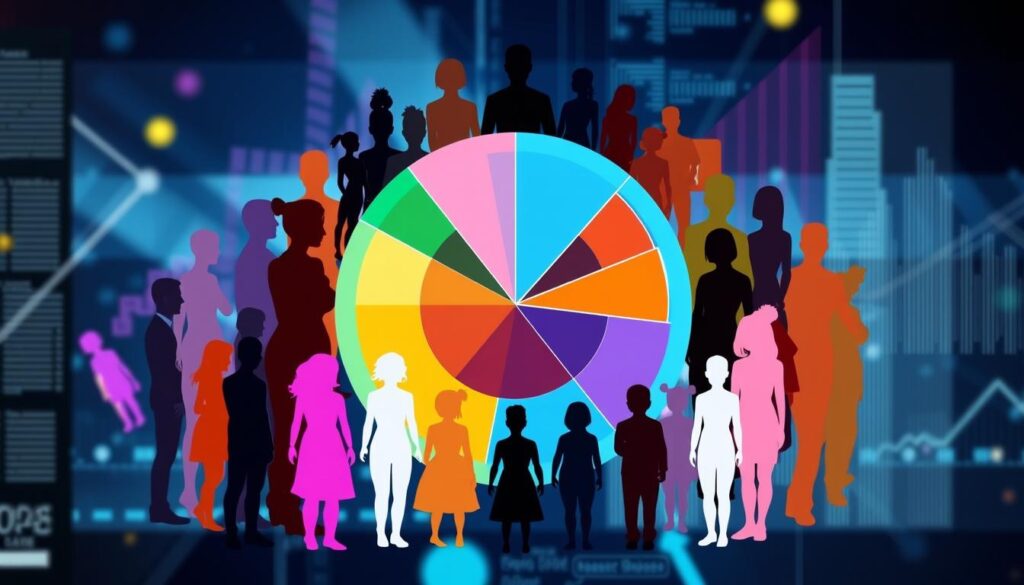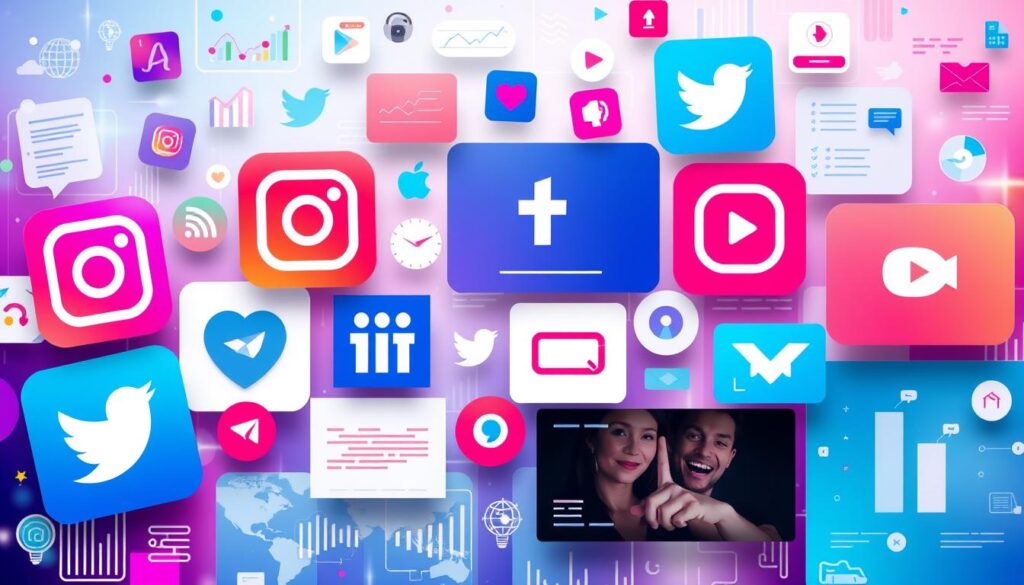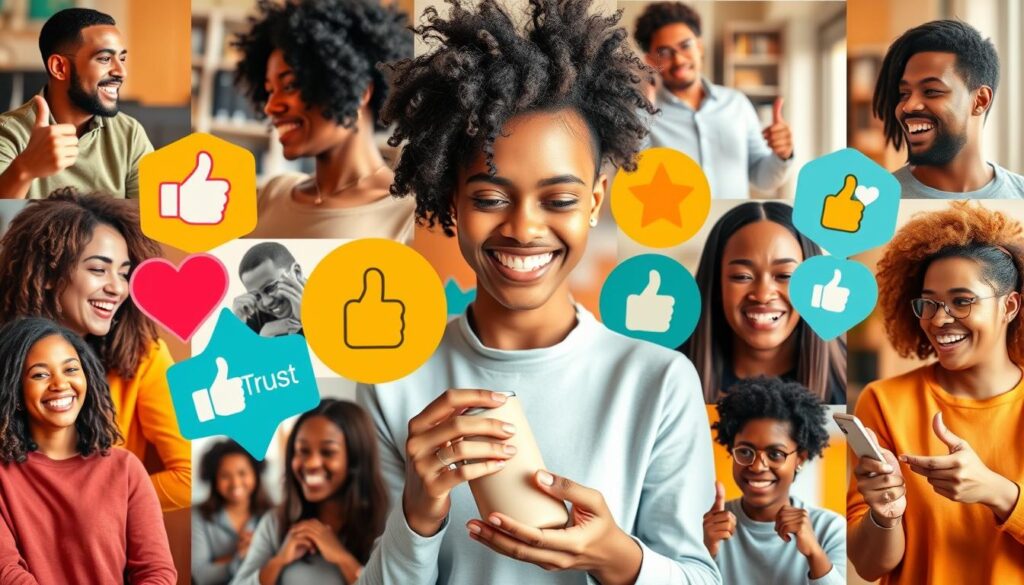Ever wondered why some brands do well on social media and others don’t? It’s all about visual content creation. Today’s fast world needs more than just text to grab attention. Using creative visuals, infographics, and videos can make your message stand out and leave a mark on your audience.
At Ceros, we know how key visual content creation is for engagement and loyalty. Our platform lets businesses make amazing multimedia content without coding. By using visual storytelling, you can make complex ideas simple, touch hearts, and get people to act.
With the right design tools and skills like image editing, graphic design, and photo manipulation, your digital artwork can become unforgettable. Our team is here to help you unleash your creativity. We’ll help you create visual stories that connect with your audience.
Key Takeaways:
- Visual content is processed faster by the human brain compared to text, making it more impactful in conveying messages.
- Creative visuals, infographics, and videos enhance engagement and help build brand loyalty.
- Visual storytelling simplifies complex ideas, evokes emotions, and inspires action from the target audience.
- Design tools and techniques such as image editing, graphic design, and photo manipulation are essential for creating captivating digital artwork.
- Ceros empowers businesses to create stunning multimedia content without coding expertise, unleashing creativity and crafting compelling visual narratives.
The Power of Visual Content in Digital Marketing
In today’s fast-paced digital world, grabbing our audience’s attention is tough. With so much info at our fingertips, businesses need to use digital marketing strategies that stand out. Visual content is key to doing this.
Capturing Attention in a Fast-Paced Digital World
Visual content is processed by the brain 60,000 times faster than text. This makes it a great way to grab attention in a time-sensitive world. Websites with good visuals attract more visitors and keep them longer.
Research shows content with images gets 94% more views than text-only content. This shows how big of a role visuals play in keeping people engaged.
| Visual Content Type | Engagement Impact |
|---|---|
| Images | 94% more views |
| Videos | 82% of global internet traffic by 2022 |
| Infographics | 3 times more shares than other content |
Communicating Complex Ideas Effectively
Visual content is great for making complex ideas simple. Using infographics, videos, and other visual tools helps us explain tough topics easily. This is crucial for topics that might confuse or lose our audience’s interest.
65% of people are visual learners, emphasizing the importance of visual content in conveying messages effectively in digital marketing.
Visual content also boosts conversion rates in digital channels. By using attention-grabbing visuals that match our brand, we make our message more compelling. This leads to better engagement and more conversions.
As we move forward in the digital world, using visual content in our marketing is essential. It helps us grab attention, explain complex ideas, and boost engagement. This puts our brand in a strong position in the fast-paced digital marketing scene.
Understanding Your Target Audience
To make engaging visual content, knowing your audience well is key. You need to know their demographics, likes, and what they struggle with. This way, you can make content that speaks to them personally. It grabs their attention and makes them want to share it.

Doing deep market research and audience analysis is the first step. A study by MIT found that images are processed by the brain in just 13 milliseconds. This makes visual content more engaging and easier to understand. By making your visuals match your audience’s interests, you can make a bigger impact.
Identifying Demographics, Preferences, and Pain Points
To really understand your audience, look at a few key things:
- Age range
- Gender
- Location
- Education level
- Income bracket
- Interests and hobbies
- Challenges and pain points
By studying these, you can make content that meets your audience’s needs. For example, if your audience is young and tech-savvy, use interactive and trendy visuals. This will grab their attention and get them involved.
Tailoring Visual Content to Audience Interests
With a clear picture of your audience, tailor your content. Studies show that content with images gets 94% more views than text-only content. By making visuals that match your audience’s interests, you’ll get more views, shares, and memories.
Here are some stats to keep in mind when tailoring your content:
| Content Type | Engagement Boost |
|---|---|
| Image-rich content | 2x more traffic, 30% more shares, 25% more backlinks |
| Tweets with photos | 35% increase in retweets |
| Tweets with videos | 28% boost in retweets |
By using these insights and making content that fits your audience, you can engage them well. The secret to success is knowing your audience and creating visuals that speak to them personally.
Infographics: Simplifying Complex Information
In today’s fast-paced digital world, grabbing and keeping audience attention is tough. Infographics have become a key tool for making complex info simple and clear. They use data, visuals, and shareable content to boost engagement, increase website visits, and help people understand information better.
Elements of Effective Infographic Design
Creating a great infographic needs careful thought about design elements. A good infographic should have a clear structure that guides the reader smoothly. Colors, fonts, and layout are crucial for making it look good and easy to read. Adding icons and images also helps make the content more interesting.
| Design Element | Purpose |
|---|---|
| Color | Enhances visual appeal and guides the reader’s attention |
| Typography | Improves readability and emphasizes key points |
| Layout | Organizes content in a logical and easy-to-follow manner |
| Icons and Images | Supports the message and makes the content more engaging |
Telling Compelling Stories Through Infographics
Infographics are great for telling stories and connecting with people. By mixing data, visuals, and stories, they can share complex ideas and touch emotions. To make a story in an infographic, focus on:
- Identifying the key message or theme
- Organizing information in a logical sequence
- Using visuals to support and enhance the narrative
- Incorporating storytelling techniques to create an emotional connection with the audience
A picture is worth a thousand words, and an infographic is worth even more. It’s a powerful tool for turning complex data into a simple, engaging, and shareable story.
Maximizing the Shareability of Infographics
Infographics can go viral and be shared widely. When done right, they can spread fast on social media and reach many people. To make infographics more shareable, try these tips:
- Create content that resonates with your target audience
- Use catchy and descriptive titles and headlines
- Optimize the infographic for various social media platforms
- Include social sharing buttons and encourage readers to share
- Promote the infographic through multiple channels, such as email newsletters and paid advertising
By using infographic design, data visualization, visual storytelling, and shareable content, businesses can engage their audience, simplify complex info, and achieve meaningful results in digital marketing.
Videos: Dynamic Storytelling for Audience Engagement
In today’s fast-paced digital world, video content is a key tool for engaging audiences. Platforms like TikTok have made video marketing more important. Google searches for TikTok ads have jumped by over 99 times in five years.
Dynamic storytelling through videos helps brands connect with their audience on an emotional level. By creating unique stories, businesses can grab attention and build a deeper connection. Studies show that the best length for a Facebook video is 2 to 5 minutes.

When making videos, it’s important to think about the attention span on different platforms. Visual storytelling grabs attention quickly and keeps it. This way, brands can share complex ideas, show off products, and stir emotions that engage the audience.
The success of visual storytelling relies on authenticity and credibility. Brands that focus on genuine connections and clear communication build trust with their audience.
To make the most of video marketing, businesses should follow a strategic plan:
- Set a clear goal and know your target audience
- Create a compelling story that fits your brand and audience
- Make sure the video looks great and is engaging
- Adjust videos for different platforms and devices
- Plan how to promote your video to reach more people
Digital ad spending is expected to hit $271.2 billion in 2023. 57% of businesses plan to spend more on video marketing. By using dynamic storytelling in videos, brands can connect with their audience, build emotional bonds, and achieve real results in the digital world.
Leveraging Visual Content on Social Media Platforms
Social media marketing is key for businesses to connect with their audience today. Visuals like images, videos, and infographics are crucial. They grab attention and boost user interaction on social media. Our brains process images 20 times faster than text, making visuals a strong way to share messages.

Tailoring Visuals for Different Social Networks
Each social media site has its own style and what users like to see. To get the most out of your marketing, make visuals that fit each platform’s vibe. For instance, Instagram and Pinterest love eye-catching images and infographics. Twitter, on the other hand, prefers short, snappy content and GIFs to get messages across quickly.
| Social Media Platform | Visual Content Preferences | Engagement Statistics |
|---|---|---|
| High-quality images, short videos, stories, and reels | Over 95 million posts shared daily | |
| Short videos, GIFs, and images with concise text | Tweets with GIFs or videos receive 3x more engagement | |
| YouTube | Long-form videos, tutorials, and product demonstrations | Videos averaged 23.1 hours of engagement monthly |
| TikTok | Short-form, creative, and entertaining videos | Generated 35 billion post views on its For You page in January 2023 |
Encouraging User Engagement and Interaction
Visuals not only catch the eye but also encourage people to get involved on social media. Interactive stuff like polls, quizzes, and live videos create a community feel. They make users want to talk back to your brand. Plus, using content from your followers adds a real touch to your social media presence.
30% of users consider accessible visuals as a key driver for sharing content, revealed in a 2022 study by Demand Gen Report.
To boost user interaction, make your social media posts easy to access. Simple steps like adding alt text to images and providing transcripts for videos help. This way, you reach more people and make your content welcoming to everyone.
By using the right visuals on social media and tailoring them to each platform, you can really connect with your audience. This builds your brand and leads to meaningful interactions with your target market.
User-Generated Visual Content: Authenticity and Trust
In today’s digital world, user-generated content (UGC) is key for brands to show their true side. Photos and videos from real customers add credibility. This helps brands connect with their audience in a real way.

Studies show 93% of people trust friends and family more than brands. This makes user-generated content very important. Seeing real people talk about a product makes a brand seem more genuine and trustworthy.
Encouraging User Participation and Content Creation
To use user-generated visuals well, brands need to encourage their customers. One good way is to create special hashtags for social media. For example:
- lululemon used #thesweatlife to get more people to share their fitness moments, boosting brand awareness.
- LaCroix’s #LiveLaCroix campaign shows how anyone can be featured, making the brand more relatable.
By letting customers share their stories, brands get a lot of real content. This content speaks to the audience in a way that feels true.
Building Brand Community Through User-Generated Visuals
User-generated content does more than just build trust. It also creates a community around a brand. When customers see their content shared, they feel valued and connected. This makes them more likely to share their own stories.
Well Traveled, a travel brand, uses member content to show the benefits of joining. It highlights the quality of their partners’ offers.
By sharing user-generated visuals, brands build a sense of belonging. This loyalty leads to more advocacy and engagement from customers.
| Statistic | Percentage |
|---|---|
| Consumers who trust online reviews as much as personal recommendations | 88% |
| Consumers who read online reviews before making a purchase decision | 93% |
| Consumers more likely to trust a brand that shares user-generated content | 86% |
The numbers show how big of a deal user-generated content is. It’s not just about trust; it’s about driving loyalty and engagement too.
The Role of Emotions in Visual Storytelling
In today’s digital world, making an emotional connection is key to brand storytelling. Videos and images can stir strong feelings in viewers. This lets businesses connect deeply with their audience. By understanding emotions and creating relatable characters, brands can tell stories that touch their audience’s hearts.

Being real and relatable is crucial for emotional storytelling. When brands share stories that people can relate to, they build a strong bond. This bond can influence buying decisions and keep customers loyal for a long time. By adding conflict and tension, brands can take their audience on an emotional ride, making them feel invested.
Visuals greatly affect the story’s emotional feel. The right colors, lighting, and camera angles can guide the viewer’s feelings. Music and sound effects also play a big role, making the story more memorable and immersive.
“Emotion is the driving force behind visual storytelling. It’s what connects us to the characters, the story, and ultimately, the brand.” – Sarah Johnson, Creative Director at Emotive Media
Visual storytelling follows key principles like structure, emotion, and consistency. Using these well, brands can make their content more engaging and impactful. This helps in reaching more people, making their message clear across different cultures.
| Brand | Visual Storytelling Approach | Emotional Impact |
|---|---|---|
| Patagonia | Photography and headlines highlighting conservation efforts | Inspires a sense of environmental responsibility and activism |
| Nike | Minimalist designs, bold headings, and powerful imagery | Evokes feelings of determination, empowerment, and athletic excellence |
| Calm | Soothing color palette and immersive visuals | Creates a sense of tranquility, relaxation, and mindfulness |
By focusing on emotions in their visual stories, brands can make content that inspires and connects. As the digital world keeps changing, mastering emotional storytelling will be vital for businesses to stand out and build strong customer relationships.
Maintaining Visual Consistency for Brand Recognition
In today’s digital world, keeping a consistent brand look is key for strong brand recognition. A unified visual language across all marketing channels makes a brand memorable and trustworthy. This resonates well with the target audience.
Establishing a Cohesive Brand Identity
A strong brand identity starts with visual branding. Defining a clear visual language, including colors, fonts, and logo use, makes a brand instantly recognizable. Here are some important stats:
- 72% of consumers say consistent visual branding builds trust in a brand’s reliability and professionalism.
- 87% of consumers find it easier to recognize a brand with consistent visual identity.
- Businesses with consistent visual branding see a 23% boost in brand recognition.
Investing in a unified brand identity boosts recognition and trust. It shows quality and professionalism. This strengthens customer loyalty and engagement.
Ensuring Consistent Use of Colors, Fonts, and Imagery
To keep a consistent look, it’s vital to use colors, fonts, and imagery the same way everywhere. A clear color palette and consistent fonts create a cohesive style. Using images that match your brand’s personality and audience also helps.
| Brand Element | Impact on Brand Recognition |
|---|---|
| Color Palette | Using the same colors helps recognize your brand and evokes feelings tied to it. |
| Fonts | Consistent fonts make your visual style cohesive and boost recognition. |
| Imagery | Using the same images that reflect your audience and brand elements strengthens your identity. |
65% of consumers see a consistent brand identity as a sign of quality.
Clear brand guidelines and consistent use across all visual content streamline marketing. This consistency improves recognition and builds long-term loyalty and engagement.
Keeping a consistent visual look is an ongoing effort. Regularly checking your visual content against your brand guidelines is crucial. This helps strengthen your brand identity and stand out online.
Optimizing Visuals for Search Engine Visibility
In today’s digital world, many businesses focus on written content but overlook visual elements. Yet, images are key to grabbing attention and improving user experience. To make visual content more impactful, we must optimize images for search engines and speed up page loading.
Incorporating Relevant Keywords in Image Alt Text and File Names
Search engines like Google use text to understand images. Adding relevant keywords in alt text and file names boosts visual content’s search visibility. Alt text helps visually impaired users and search engines grasp an image’s meaning. Optimizing images can increase website traffic and user engagement.
- Over 50% of consumers find visual information more influential than text in their buying decisions.
- 61% of consumers say visual search improves their in-store browsing.
- 62% of millennials and Gen Zers are interested in visual search in search engines.
Improving Page Load Speed for Visual Content
Page speed affects search rankings and user experience. Slow pages lead to high bounce rates and less engagement. To speed up visual content, compress images without losing quality. Choose the right file format and use content delivery networks for better page speed.
Compressing images can improve website speed and user experience, leading to better search rankings and satisfaction.
Page speed’s impact on search visibility is clear from the data:
| Page Load Time | Bounce Rate |
|---|---|
| 1-3 seconds | 32% |
| 4-6 seconds | 90% |
| 7-10 seconds | 106% |
| 11+ seconds | 123% |
Compressing images and submitting image sitemaps to Google Search Console helps index visual content. Using structured data for images can also enhance search results and visibility.
By focusing on image optimization and page speed, we can fully leverage visual content. This drives search engine visibility and engages our audience effectively.
Measuring the Impact of Visual Content
Visual content performance is key in digital marketing. We track engagement and ROI to see how well our content works. This helps us make smart choices to improve our strategies.
We look at likes, shares, comments, and click-through rates to see how our content does. These numbers tell us how our audience interacts with our content. We also check how far our content spreads on social media to plan better.
We also watch page views, unique visitors, and referral traffic. This shows us how well our content brings people to our site. By looking at conversion rates and lead generation, we see how our visuals help our business grow.
| Metric | Purpose | Insights |
|---|---|---|
| Engagement (Likes, Shares, Comments) | Gauge popularity and relevance | Identify high-performing content and optimize future strategies |
| Click-Through Rate (CTR) | Measure effectiveness in driving traffic | Optimize visuals and calls-to-action for better conversions |
| Social Media Reach | Assess content spread across platforms | Adjust distribution strategies for maximum exposure |
| Conversion Rate | Measure impact on business objectives | Align visual content with desired actions and ROI goals |
We do A/B testing to find the best visuals for our audience. By trying different formats and styles, we find what works best. This helps us make our content more appealing to our target audience.
Regular reporting is key to keeping track of our visual content’s performance. By making reports on key metrics and ROI, we ensure our content is valuable. It also helps us meet our marketing goals.
As we improve our visual content marketing, we must keep up with new trends and tech. Using AI and personalization, we can make visuals that really connect with our audience. This helps our brand achieve its goals.
The Future of Visual Content: Emerging Trends
Technology is changing fast, and so is visual content. Brands are looking into new ways to market themselves. They want to grab attention and offer unique experiences. Let’s explore what’s next in visual content.
Interactive and Immersive Experiences
Interactive and immersive experiences are big now. Brands use VR and AR to connect with people in new ways. These experiences let users dive into virtual worlds and explore products in a fresh light.
Things like 360-degree videos and interactive infographics are also popular. They let users get involved and stay longer. This not only grabs attention but also helps brands understand what people like.
The Rise of Augmented Reality in Visual Marketing
Augmented reality is changing how brands show off their products. It lets users see digital info on top of the real world. This is especially useful in retail, where customers can try on clothes virtually.
AR marketing campaigns are really effective. They offer personalized experiences that help customers understand what they’re buying. As AR gets easier to use, we’ll see more creative marketing everywhere.
| Trend | Impact on Visual Marketing |
|---|---|
| Interactive Experiences | Increased engagement, longer dwell times, and valuable user insights |
| Immersive Technologies (VR/AR) | Memorable brand experiences, enhanced product visualization, and personalized interactions |
| Augmented Reality | Virtual product trials, contextual experiences, and improved customer decision-making |
As we move forward, brands that use these trends will shine. They’ll grab attention and connect with people in meaningful ways. By focusing on interactivity, immersion, and AR, businesses can achieve their marketing goals.
Visual Content Creation: Best Practices and Tools
To make engaging visual content, we need to follow visual content best practices and stick to key design principles. The right content creation tools help us work better and make top-notch visuals that connect with our audience.
Essential Design Principles for Engaging Visuals
Knowing and using basic design principles is key for making content that looks good. Important principles include:
- Composition: Arrange elements in a balanced way to guide the viewer’s eye.
- Color theory: Use colors to evoke feelings, create contrast, and show brand identity.
- Typography: Pick fonts that are easy to read and match your brand’s vibe.
- Consistency: Keep a consistent look across all platforms to boost brand visibility by 23%.
Following these design principles helps us make visuals that look great and get our message across. Studies show that using high-quality visuals can boost user engagement by up to 80%.
Top Tools for Creating Infographics and Editing Videos
To make creating visual content easier, we can use infographic tools and video editing software. Some top picks are:
| Tool | Description | Key Features |
|---|---|---|
| Canva | A user-friendly graphic design tool with lots of templates and assets. | Offers basic features for free, but advanced tools like background remover need Canva Pro. |
| Infogram | An interactive tool for making infographics, charts, and maps. | Free version has access to templates, but limits users to 10 projects. |
| Lumen5 | A tool that turns blog posts and articles into engaging videos. | Free version lets users make up to 5 videos a month with a watermark. |
| Adobe Creative Suite | A set of tools for graphic design, video editing, and more. | Includes industry-standard software like Photoshop, Illustrator, and Premiere Pro. |
Using these content creation tools helps us make professional visuals that grab attention. A Content Marketing Institute article shows that using design software can boost visual content quality by 45%.
In a 2023 study by Venngage, 80% of marketers said visual content was “Very important” to their strategy or said it was essential.
By sticking to visual content best practices, mastering design principles, and using great infographic tools and video editing software, we can make visuals that work and leave a strong impression on our audience.
Conclusion
In today’s fast-paced digital world, a strong visual content strategy is key to marketing success. Visual content boosts brand awareness by 80% and engages audiences 2.3 times more than text. By creating visuals that match our audience’s interests, we can share complex ideas, stir emotions, and build a strong brand connection.
Creating compelling infographics and dynamic videos opens up many storytelling opportunities. Using user-generated content adds authenticity and trust, increasing customer loyalty by 34%. Keeping our visuals consistent across all platforms is vital for a unified brand identity that our audience will love.
The future of visual content is exciting, with interactive and immersive experiences like augmented reality on the horizon. By keeping up with trends and improving our visual content strategy, we can lead the visual revolution. This will help us captivate our audience and achieve significant results for our brand. Embracing visual content allows us to make lasting connections, inspire action, and leave a lasting impression on our audience.
FAQ
How can visual content help businesses engage their audience effectively?
Visual content, like infographics and videos, grabs attention fast. It makes complex ideas easy to understand. This way, businesses can connect with their audience better, stir emotions, and make a lasting impression.
What are the key elements of effective infographic design?
Good infographic design needs accurate data, a clear flow, and a mix of visuals and text. A great infographic tells a story, keeps the audience interested, and is easy to share.
How can businesses leverage visual content on social media platforms?
By making visuals fit each social media platform, businesses can get better engagement. Using polls, stories, and user content builds a community. This helps the brand’s visuals reach more people.
What role does user-generated visual content play in building brand trust?
User-generated content, like reviews and photos, makes a brand seem real. It shows people’s experiences, building trust with others. This content spreads through social media and word of mouth.
How can businesses maintain visual consistency for brand recognition?
Keeping a consistent look with colors, fonts, and images is key. This makes the brand easy to remember. It strengthens the brand’s impact and keeps it in people’s minds.
What are the best practices for optimizing visuals for search engine visibility?
To help visuals show up in searches, use clear alt tags and file names. Make images load fast by compressing them and using the right formats. This helps improve search rankings.
What metrics should businesses track to measure the impact of visual content?
Track shares, backlinks, and conversions for infographics. For images, watch click-through rates. On social media, look at likes, comments, and shares. This helps improve visual content strategies.
What are the emerging trends in visual content creation?
Interactive experiences like VR and AR are changing how businesses connect with people. AR, in particular, lets customers try on products virtually. This makes shopping more fun and helps with decision-making.
What tools can businesses use to create engaging visual content?
Tools like Adobe Creative Suite, Canva, and Piktochart help make professional visuals. They offer many templates and options to make content creation easier and better.

